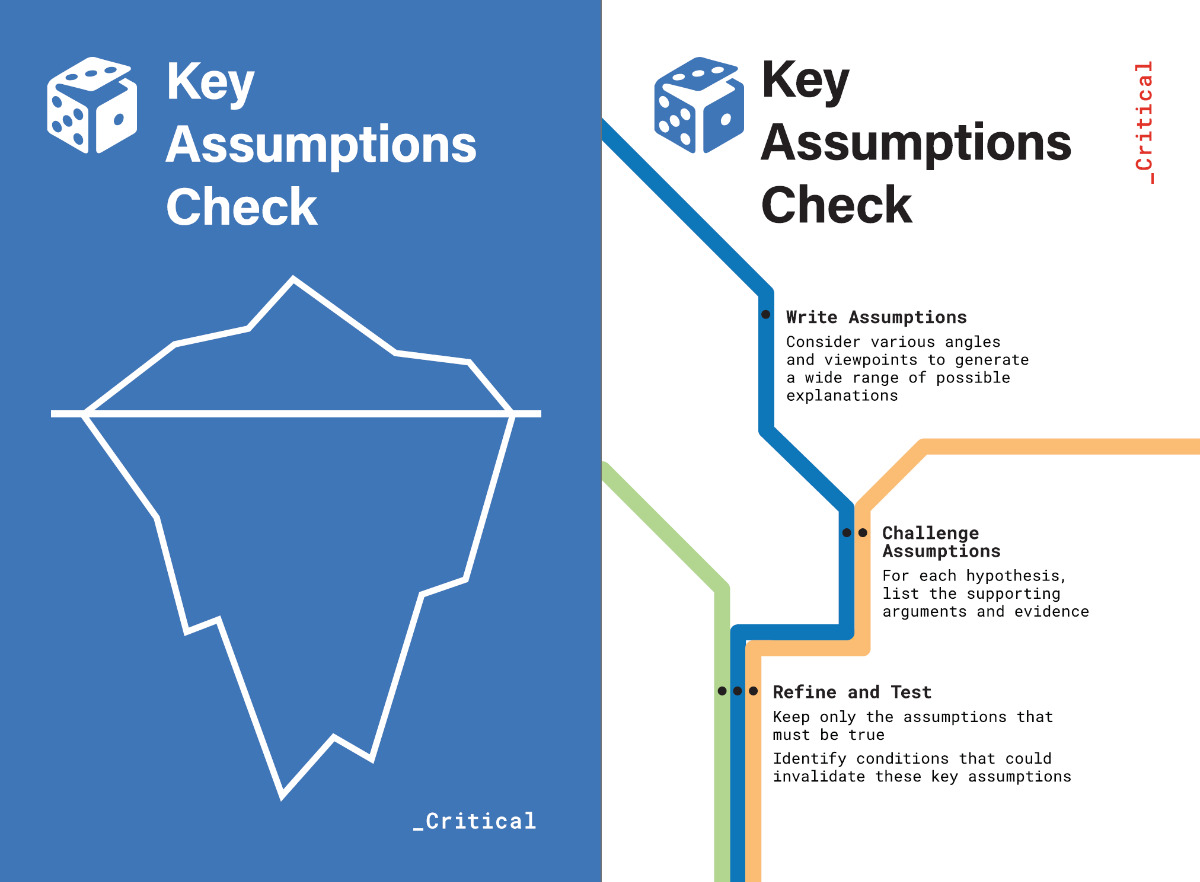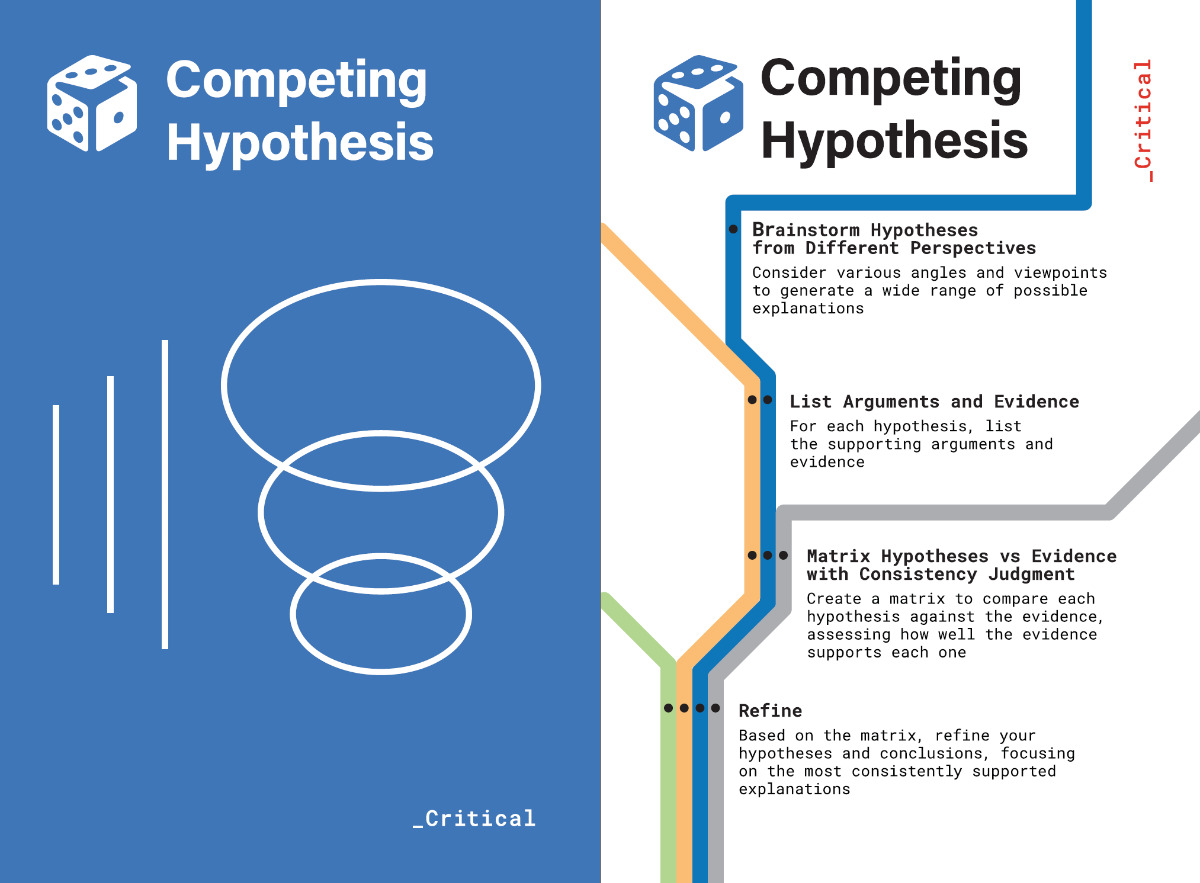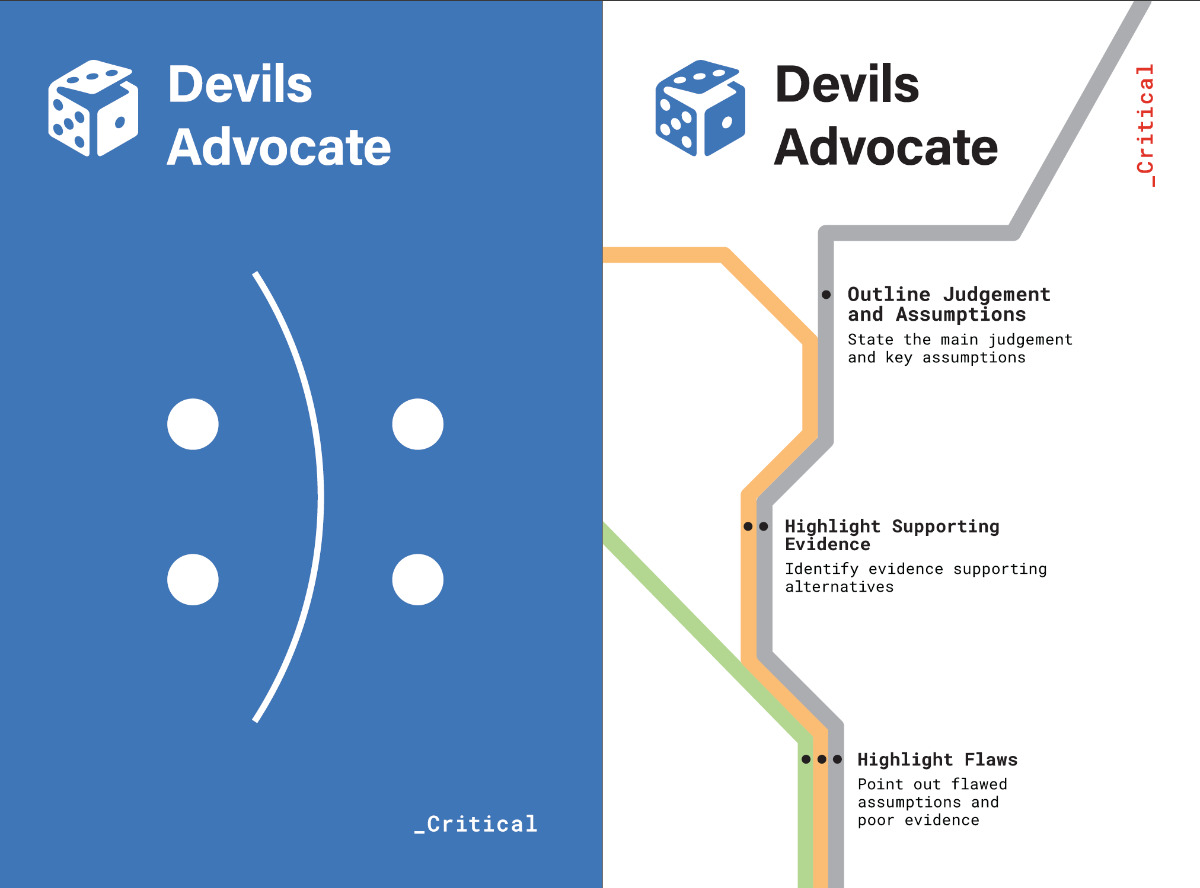Strategic Thinking Exercise Series - Week 6
Jul 28, 2025 2:51 pm
This is part 6 of our 9-part tabletop exercise series. Please read from part 1 chronologically and enjoy each week as we spotlight three exercises from our new PRISM Strategic Tabletop Exercise Guide Deck—27 decision-making tools that teams can run in real-time, in real rooms, on real challenges.
This week introduces three systematic assumption exercises in deliberate sequence—Key Assumptions Check → Competing Hypothesis → Devil's Advocate—that transform strategic confidence into strategic validity by systematically identifying, testing, and challenging the foundational beliefs underlying your carefully prepared implementation.
Why this specific progression works: Assumption identification first (surface hidden strategic premises), alternative development second (challenge assumption monopolies with competing explanations), systematic attack third (institutionalise scepticism to prevent groupthink). Each exercise addresses different cognitive biases that protect invalid assumptions from correction.
The meta-principle: The most dangerous assumptions are the ones everyone agrees on. Consensus creates comfort, not truth. Strategic success requires systematic discomfort with foundational beliefs until validated through structured challenge rather than group agreement. This sequence provides assumption insurance while maintaining strategic direction.
🎲 Key Assumptions Check – Truth Audit
What: Systematic identification and validation methodology that surfaces hidden strategic assumptions, maps their supporting evidence, and identifies conditions that would invalidate core strategic premises before they can cause expensive failures.
Why: Most strategic assumptions remain invisible until they're violated. Teams build elaborate plans on unexamined beliefs about customers, markets, capabilities, and competitive dynamics. Assumption excavation transforms implicit beliefs into explicit hypotheses that can be tested and validated.
When to deploy: Following risk preparation, when implementation foundations need validation, strategic planning sessions, before significant resource commitments, and any situation where hidden assumptions could undermine otherwise sound execution.
The Steps
Phase 1: Write Core Assumptions Systematically identify implicit beliefs underlying your strategy by examining decision logic. Ask "For this strategy to succeed, what must be true about customers, markets, technology, organisation, and competition?" Generate a comprehensive assumption inventory spanning all strategic domains.
Phase 2: List Supporting Arguments and Evidence For each identified assumption, document current evidence and reasoning that supports belief validity. Include quantitative data, qualitative insights, expert opinions, historical precedents, and logical arguments. Distinguish between strong and weak evidence (independent validation) (circular reasoning or wishful thinking).
Phase 3: Refine and Test Assumptions Eliminate assumptions that aren't necessary for strategic success. Keep only assumptions that must be true for strategy viability. For retained assumptions, identify specific conditions or evidence that would prove them false. Create testable hypotheses rather than untestable beliefs.
Phase 4: Develop Invalidation Conditions For each critical assumption, specify observable conditions that would indicate assumption failure. Design monitoring systems to detect assumption invalidation early enough for strategic adjustment. Build assumption testing into implementation planning.
Facilitation
Assumption excavation technique: Use systematic questioning to surface hidden beliefs. "Why would customers choose our solution?" reveals customer behaviour assumptions. "Why won't competitors respond aggressively?" reveals competitive dynamic assumptions. "Why can we execute better than alternatives?" reveals capability assumptions.
Evidence quality assessment: Distinguish between evidence types and their validation strength. First-hand research provides stronger validation than industry reports. Independent sources provide stronger validation than internal analysis. Recent evidence provides stronger validation than historical patterns in changing environments.
Necessity testing: Challenge every assumption with "Is this actually required for success?" Many apparent assumptions are preferences or conveniences rather than strategic necessities. Eliminate optional assumptions to focus testing resources on truly critical premises.
Invalidation specificity: Avoid vague invalidation conditions like "market changes significantly." Create specific, observable criteria: "Customer acquisition cost exceeds $500," "Competitor launches equivalent feature within 6 months," "Regulatory approval timeline extends beyond 18 months."
Example Applications
SaaS market expansion assumption check
Core assumptions identified:
- Customer: "European enterprises have 40% higher willingness to pay for automation than US market"
- Technology: "Current platform architecture scales to 10x user volume without major redesign"
- Competitive: "Local competitors lack integration capabilities to match our offering"
- Organisational: "Sales team can adapt enterprise methodology to European business culture"
- Regulatory: "GDPR compliance requirements won't significantly impact product development"
Supporting evidence analysis:
- Customer willingness: Based on 3 industry surveys, 12 prospect interviews, 1 pilot customer
- Technology scaling: Based on stress testing, architecture review, vendor specifications
- Competitive analysis: Based on public information, 2 competitive assessments, partner intelligence
- Sales capability: Based on past international expansion, team assessment, training evaluation
- Regulatory impact: Based on legal consultation, GDPR analysis, and compliance cost estimation
Assumption refinement:
- Customer willingness: Refined to "European enterprises in financial services sector" after evidence review
- Technology scaling: Retained as critical assumption requiring ongoing validation
- Competitive advantage: Refined to "18-month competitive lead time" with specific capability gaps
- Sales adaptation: Retained with specific cultural training and local partnership requirements
- Regulatory compliance: Retained with ongoing legal monitoring and cost contingency
Invalidation conditions:
- Customer: "Less than 15% of prospects accept pricing premium over local alternatives"
- Technology: "Response times exceed 2 seconds at 5x current user volume"
- Competitive: "Major competitor launches equivalent integration within 12 months"
- Sales: "Team conversion rates 50% below US performance after 6 months"
- Regulatory: "Compliance costs exceed 20% of development budget"
Pattern Recognition
Assumption cascades: Related assumptions often depend on each other, creating fragile foundation chains. Customer willingness to pay depends on product differentiation, technical capability, and talent availability. Map assumption dependencies to identify critical path vulnerabilities.
Evidence quality gradients: Teams often mix strong and weak evidence without distinction. Survey data from 1000 customers provides a stronger validation than the opinions of 3 executives. Weight evidence appropriately and seek stronger validation for weaker assumptions.
Temporal assumption decay: Assumptions valid today may become invalid as conditions change. Market, technology, and competitive assumptions require regular revalidation as environments evolve.
Integration and Maintenance
Decision frame connection: Assumptions should directly support Week 2 decision framing objectives and success criteria. If assumptions feel disconnected from strategic goals, either the assumptions are irrelevant or decision frame needs refinement.
Risk integration: Connect assumption monitoring to Week 5 tripwire systems. Assumption invalidation provides early warning of strategic problems requiring response protocols.
Evaluation validation: Review Week 4 evaluation criteria against assumption analysis. If evaluation assumed customer preferences or competitive responses, those assumptions need systematic validation rather than evaluation confidence.
🎲 Competing Hypothesis – Counter-story
What: Systematic alternative theory development methodology that challenges assumption monopolies by generating competing explanations for the same strategic situation, then rigorously testing each explanation against available evidence.
Why: Single explanations create cognitive anchoring and confirmation bias. Teams seek evidence supporting their preferred theory while ignoring contradictory information. Competing hypothesis methodology forces consideration of alternative explanations and more rigorous evidence evaluation.
When: Following assumption identification when strategic premises need challenge, during strategic analysis, before major decisions, any situation where alternative explanations could lead to different strategic choices.
The Steps
Stage 1: Brainstorm Hypotheses from Different Perspectives Generate multiple competing explanations for the same strategic situation or decision context. Consider various angles and viewpoints: customer perspectives, competitor perspectives, technology evolution, market dynamics, organisational capabilities. Aim for 4-6 distinct explanations that could account for current conditions.
Stage 2: List Arguments and Evidence for Each Hypothesis For each competing explanation, systematically document supporting arguments and evidence. Include quantitative data, qualitative insights, logical reasoning, and precedent examples. Treat each hypothesis as potentially valid rather than defending preferred explanations.
Stage 3: Create Matrix of Hypotheses vs Evidence with Consistency Judgment Develop a systematic comparison matrix evaluating how well each piece of evidence supports each competing hypothesis. Use consistent scoring: strong support, moderate support, weak support, neutral, contradictory. This reveals which explanations have the strongest foundation of evidence.
Stage 4: Refine Understanding Based on Matrix Analysis Based on evidence matrix, refine strategic understanding and conclusions. Focus on explanations with strongest evidence support while acknowledging uncertainty where evidence conflicts. Avoid premature convergence on single explanation when evidence remains ambiguous.
Facilitation
Perspective multiplication: Generate hypotheses from systematically different viewpoints. Internal vs external perspectives, optimistic vs pessimistic assumptions, technology-driven vs market-driven explanations, short-term vs long-term viewpoints. Perspective diversity improves explanation completeness.
Evidence objectivity: Evaluate evidence independently for each hypothesis rather than seeking evidence to support preferred explanations. Ask "How well does this evidence support Hypothesis A? Hypothesis B? Hypothesis C?" rather than "Does this evidence support our preferred approach?"
Matrix discipline: Use consistent scoring criteria across all hypothesis-evidence combinations. Define scoring categories clearly: "Strong support means evidence directly validates hypothesis and contradicts alternatives." Avoid scoring inflation for preferred hypotheses.
Premature convergence resistance: Maintain multiple viable hypotheses longer than feels comfortable. Cognitive desire for single explanations creates premature elimination of competing theories. Evidence ambiguity often requires sustained uncertainty rather than forced resolution.
Example Application
Customer churn analysis competing hypotheses:
Strategic situation: "Customer churn increased 35% in Q3 despite product improvements and pricing adjustments."
Competing explanations generated:
- Product-market fit degradation: Core product no longer meets evolving customer needs
- Competitive displacement: New competitor offering superior value proposition
- Economic sensitivity: Customers reducing software spend due to economic uncertainty
- Service delivery problems: Customer success and support quality decline affecting retention
- Pricing strategy misalignment: Recent pricing changes triggered customer evaluation and switching
Evidence evaluation matrix:
- Customer exit interviews: Strong support for service problems, moderate support for competitive displacement, weak support for economic factors
- Usage analytics: Strong support for product-market fit issues, moderate support for competitive features, neutral on service delivery
- Market research: Strong support for economic sensitivity, moderate support for competitive pressure, weak support for pricing issues
- Win/loss analysis: Strong support for competitive displacement, moderate support for pricing strategy, weak support for product-market fit
- Support ticket trends: Strong support for service delivery problems, neutral on other hypotheses
Matrix insights: Service delivery problems and competitive displacement show the strongest support evidence. Product-market fit degradation has mixed evidence. Economic sensitivity is supported by external research but contradicted by customer behaviour. Pricing strategy shows the weakest evidence of support.
Strategic implications: Focus retention strategy on service delivery improvement and competitive differentiation rather than product redesign or pricing adjustment. Monitor economic sensitivity indicators but don't optimise primarily for price competition.
Pattern Recognition
Explanation hierarchy: Some hypotheses are subset explanations of broader theories. "Customer service problems" might be subset of "operational capability decline." Identify hierarchical relationships to avoid redundant hypothesis development.
Evidence weighting conflicts: Different evidence types support different hypotheses. Quantitative data might support one explanation while qualitative insights support another. Don't force false precision—acknowledge that different evidence types provide different insights.
Temporal explanation shifts: Competing hypotheses might be valid at different periods. Market opportunity hypothesis might be valid in the long term, while the capability mismatch hypothesis is valid short term. Consider temporal dimensions in hypothesis evaluation.
Integration and Maintenance
Option generation connection: Competing hypotheses often suggest different strategic options. If customer behaviour explanation A is correct, pursue strategy X. If explanation B is correct, pursue strategy Y. Use hypothesis analysis to guide Week 3 option generation.
Uncertainty acknowledgment: When evidence supports multiple competing hypotheses, acknowledge strategic uncertainty rather than forcing single explanation. Develop adaptive strategies that work across multiple explanations rather than optimising for single theory.
Monitoring strategy: Different hypotheses predict different future patterns. Design monitoring systems to detect which explanation proves most accurate over time, enabling strategy adjustment as clarity emerges.
🎲 Devil's Advocate – Stress Voice
What: Institutionalised scepticism methodology that assigns explicit responsibility for attacking strategic assumptions and highlighting evidence weaknesses, preventing groupthink while ensuring thorough challenge of strategic foundations.
Why: Group dynamics naturally suppress criticism and doubt. Teams develop psychological investment in strategic directions that impairs objective evaluation. Devils Advocate creates systematic opposition that surfaces flaws and risks without personal conflict or political consequences.
When: Following hypothesis development as a final assumption challenge, before significant resource commitments, during strategic reviews, any situation where groupthink could prevent identifying strategic flaws or risks.
The Steps
Phase 1: Outline Main Judgment and Key Assumptions Clearly state the strategic judgment under examination and identify the core assumptions supporting that judgment. Create an explicit target for systematic challenge by documenting strategic logic, underlying premises, and expected outcomes requiring defence.
Phase 2: Assign Systematic Opposition Role Designate specific individual or team with explicit responsibility for attacking strategic assumptions and evidence. Provide a clear mandate: identify flawed assumptions, highlight weak evidence, challenge logical connections, and surface ignored risks. Frame opposition as a strategic service, not personal criticism.
Phase 3: Present Systematic Challenge Devil's Advocate presents a comprehensive case against strategic assumptions, evidence quality, and logical reasoning. Focus on assumption flaws, evidence weaknesses, logical gaps, ignored alternatives, and unacknowledged risks. Provide specific examples and alternative interpretations.
Facilitation
Role rotation strategy: Rotate Devil's Advocate responsibility across team members rather than assigning a permanent sceptic role. This prevents role ossification and ensures all perspectives contribute to systematic challenge while maintaining team dynamics.
Challenge comprehensiveness: Provide Devil's Advocate with a systematic framework for assumption attack. Challenge evidence quality, logical reasoning, assumption necessity, alternative explanations, implementation risks, and unstated premises. A comprehensive challenge prevents selective criticism.
Constructive opposition framing: Frame Devil's Advocate as strategic insurance rather than destructive criticism. Opposition improves strategic quality by identifying weaknesses before they become expensive failures. Opposition serves strategy success, not strategy destruction.
Response integration: After the Devil's Advocate challenge, systematically address raised concerns rather than dismissing opposition. Use challenge to improve strategic assumptions, strengthen the evidence base, and develop contingency planning for identified weaknesses.
Example Applications
Product development strategy Devil's Advocate challenge:
Strategic judgment: "AI-powered customer service automation will capture 40% market share within 24 months through superior technology and faster implementation."
Key assumptions outlined:
- Technology superiority: AI capabilities exceed competitor offerings significantly
- Market readiness: Customers willing to adopt AI automation at predicted rates
- Implementation advantage: Development timeline is faster than competitor response
- Resource sufficiency: Budget and talent are adequate for execution requirements
- Competitive response: Existing players won't match capabilities within timeline
Devil's Advocate systematic challenge:
Technology assumption flaws:
- Evidence based primarily on internal testing rather than independent validation
- Superiority claims rely on features customers may not value highly
- Technology advantage assumes competitors can't access similar AI capabilities
- Performance benchmarks may not reflect real-world deployment conditions
Market readiness evidence weaknesses:
- Customer research sample size is insufficient for market prediction confidence
- Adoption rate assumptions extrapolated from early adopter behaviour
- Economic conditions could reduce the appetite for automation investment appetite
- Regulatory concerns about AI customer service are not adequately addressed
Implementation timeline vulnerabilities:
- Development estimates optimistic based on past project performance
- Integration complexity with existing systems is underestimated
- Talent acquisition requirements may exceed available market supply
- Testing and validation phases compressed unrealistically
Resource assumption gaps:
- Budget projections don't include a contingency for technical challenges
- Talent cost inflation is not factored into financial planning
- Marketing and sales requirements for new category creation are underestimated
- Customer success resources for AI product adoption are insufficient
Competitive response underestimation:
- Incumbent advantages in customer relationships and distribution channels are ignored
- Competitor financial resources for rapid response development are understated
- Partnership and acquisition strategies that competitors might pursue are not considered
- Pricing war scenarios that could eliminate profit margins are unexamined
\Strategic judgment modification: Based on Devil's Advocate challenge, modify strategy to address identified weaknesses. Extend the timeline for more realistic development. Increase budget contingency for technical and talent risks. Develop competitive response scenarios and mitigation strategies. Strengthen customer validation with larger research samples.
Pattern Recognition
Cognitive bias identification: Devil's Advocate should specifically target known cognitive biases affecting strategic thinking. Overconfidence bias in capability assessment, anchoring bias in market size estimation, confirmation bias in evidence evaluation, and availability bias in risk assessment.
Evidence source diversity: Challenge evidence quality by examining source diversity and independence. Internal analysis, vendor claims, and consultant reports provide different validation strength than independent research, customer studies, and competitive intelligence.
Assumption interdependency risks: Identify cascading assumption failures where multiple premises depend on each other. If assumption A fails, assumptions B and C also become invalid, creating systematic rather than isolated strategic risks.
Integration and Maintenance
Challenge documentation: Record all Devil's Advocate concerns and organisational responses for future validation. This creates a learning system where assumption challenges get tested against actual outcomes, improving future strategic judgment quality.
Response accountability: Assign specific responsibility for addressing each Devil's Advocate concern rather than a generic acknowledgment. This ensures that systematic challenge produces systematic improvement rather than defensive dismissal.
Ongoing opposition: Continue Devils Advocate role during implementation to challenge emerging assumptions and evidence rather than limiting opposition to initial strategic development. Strategic assumptions continue evolving and requiring challenge throughout execution.
Before > After
Before state: Strategic confidence based on untested assumptions, groupthink preventing critical challenge, foundational beliefs protected from systematic examination, implementation of potentially invalid strategies with sophisticated execution.
After state: Assumption identification and testing (excavated foundation validation), alternative explanation development (cognitive anchoring prevention), systematic opposition (institutionalised strategic scepticism), strategic validity that withstands critical challenge.
The compound effect: These three exercises provide comprehensive assumption validation across identification, alternatives, and systematic attack. Key Assumptions Check surfaces hidden premises. Competing Hypothesis challenges explanation monopolies. Devil's Advocate institutionalises systematic opposition.
Indicators
Assumption identification completeness: Percentage of strategic assumptions explicitly identified and documented (target: 90%+ of critical assumptions surfaced through systematic process).
Alternative explanation consideration: Number of competing hypotheses evaluated before strategic convergence (target: 3-5 alternative explanations systematically assessed).
Challenge comprehensiveness: Percentage of strategic assumptions that survive systematic Devil's Advocate attack (target: 80%+ of challenged assumptions validated or modified rather than dismissed).
Common Failure Modes
Assumption invisibility persistence: Conducting assumption exercises but missing critical unstated premises. Prevention: Use multiple excavation techniques and systematic questioning rather than relying on obvious assumption identification.
Hypothesis anchoring: Generating competing hypotheses but unconsciously favouring initial explanations. Prevention: Evaluate evidence independently for each hypothesis using systematic matrix methodology.
Opposition ritualisation: Assigning Devil's Advocate role but not seriously considering raised challenges. Prevention: Require specific responses to opposition concerns and document assumption modifications based on challenge results.
Your Week 6 Implementation Challenge
Apply this assumption challenge sequence to the strategy you've systematically evaluated and prepared through Weeks 4-5. Use your Week 2 domain diagnosis to calibrate challenge intensity—Complex domains need more comprehensive assumption validation than Simple domains.
Execution Protocol
Session structure: 165 minutes total
- Key Assumptions Check: 75 minutes (20 assumption identification, 25 evidence documentation, 15 refinement, 15 invalidation condition development)
- Competing Hypothesis: 60 minutes (20 alternative generation, 25 evidence matrix development, 15 analysis and refinement)
- Devils Advocate: 30 minutes (10 strategic judgment outline, 20 systematic challenge presentation and response)
Success Criteria Checklist
Key Assumptions Check completion:
[ ] Identified 8-15 core assumptions spanning customer, market, technology, organisational, and competitive domains
[ ] Documented supporting evidence with quality assessment and source independence evaluation
[ ] Refined assumptions to eliminate non-essential premises and focus on critical strategic necessities
[ ] Established specific, observable invalidation conditions for each critical assumption
[ ] Integrated assumption monitoring into existing tracking and response systems
Competing Hypothesis development:
[ ] Generated 4-6 alternative explanations for strategic situation from different perspectives
[ ] Created systematic evidence matrix evaluating support for each competing hypothesis
[ ] Identified hypotheses with strongest evidence foundation and areas of genuine uncertainty
[ ] Refined strategic understanding based on multi-hypothesis analysis rather than single explanation
[ ] Developed monitoring strategy to detect which explanations prove most accurate over time
Devil's Advocate challenge execution:
[ ] Assigned explicit opposition role with comprehensive challenge mandate
[ ] Presented systematic attack on strategic assumptions, evidence quality, and logical reasoning
[ ] Identified specific flaws in assumption validity, evidence independence, and strategic logic
[ ] Generated organisational responses addressing raised concerns rather than dismissing opposition
[ ] Modified strategic approach based on validated challenges and identified weaknesses
Diagnostic Signals and Responses
Positive indicators:
- Assumption revision: Strategic understanding changes based on systematic challenge rather than remaining unchanged through opposition.
- Evidence strengthening: Challenge process identifies evidence gaps that get addressed through additional validation rather than ignored.
- Alternative consideration: Team genuinely considers competing explanations rather than seeking evidence to support preferred theories.
Warning signals:
- Challenge resistance: If systematic opposition gets dismissed without specific responses, groupthink dynamics prevent beneficial assumption validation.
- Evidence dismissal: If competing hypothesis analysis doesn't change strategic understanding, evidence evaluation may lack objectivity or comprehensiveness.
- Assumption multiplication: If assumption identification generates 20+ premises, focus on truly critical assumptions rather than an exhaustive assumption inventory.
Domain-Specific Calibration
Simple domain approach: Focus on execution assumptions and best practice validity. Minimal alternative hypothesis development needed. Devil's Advocate challenges implementation assumptions rather than strategic premises.
Complicated domain approach: Balance technical and market assumptions with expert validation. Moderate alternative hypothesis development for technical explanations. Devil's Advocate challenges both technical and strategic reasoning.
Complex domain approach: Comprehensive assumption challenge across all categories. Extensive alternative hypothesis development for emergent explanations. Devil's Advocate challenges fundamental strategic premises and system assumptions.
Chaotic domain approach: Focus on survival assumptions and rapid validation requirements. Alternative hypothesis development for crisis response explanations. Devil's Advocate challenges whether strategic planning assumptions remain valid under crisis conditions.
The Bridge to Systems Perspective
Assumption challenge complete. Strategic foundations validated through systematic opposition. Hidden premises identified and tested. Alternative explanations evaluated. Core beliefs are strengthened through critical examination. You need a systems perspective to understand how your validated strategy operates within broader organisational and environmental contexts.
Progression: Week 1 taught rapid decision-making. Week 2 taught precision framing. Week 3 taught option generation. Week 4 taught evaluation. Week 5 taught risk anticipation. Week 6 taught assumption validation. Week 7 will teach systems thinking—the perspective that determines whether validated strategies create sustainable competitive advantage or temporary tactical gains.
The foundation-to-system bridge: Assumption validation ensures strategic premises are sound, but the systems perspective determines whether sound strategies create lasting value within complex organisational and competitive environments. Individual strategy excellence without systems integration often produces local optimisation that undermines global strategic coherence.
Strategically sound initiatives fail to create lasting competitive advantage because they optimise individual elements without understanding system dynamics, feedback loops, and constraint relationships that determine sustainable value creation.
Next focus: From assumption validation to systems perspective—three exercises that transform validated strategies into systems-integrated approaches by mapping causal relationships, identifying constraints, and understanding competitive positioning within evolving strategic landscapes.
Because you can validate every strategic assumption perfectly and fail systemically if your strategy doesn't account for the complex relationships, feedback loops, and constraint dynamics that determine sustainable competitive advantage in interconnected business environments.
Ready to master systematic strategic thinking? Get the complete PRISM Strategic Tabletop Exercise Guide with all 27 exercises, facilitation guides, and advanced techniques. Transform your team's decision-making in real-time, in real rooms, on real challenges.
Get the full stack PRISM Tabletop Exercise set here for AUD 40, and unlock all 27 exercises.




